Monitoring the Changes in Heat Transfer and Water Evaporation of French Fries during Frying to Analyze Its Oil Uptake and Quality
Abstract
1. Introduction
2. Materials and Methods
2.1. Samples Preparation
2.2. Core Temperature and Heat Transfer Coefficient (h)
2.3. Water Content
2.4. Water Loss Kinetics of French Fries
2.5. Oil Content
2.6. The Oil Uptake Kinetics
2.7. Color
2.8. Texture
2.9. Sensory Evaluation
2.10. Statistical Analysis
3. Results and Discussion
3.1. Core Temperature
3.2. Water Content and Kinetic Modeling of French Fries
3.2.1. Water Content
3.2.2. Water Loss Kinetic Modeling
3.3. Oil Uptake and Kinetic Modeling of French Fries
3.3.1. Oil Content
3.3.2. Oil Uptake Kinetic Modeling
3.4. Color
3.5. Texture
3.6. Sensory Evaluation
4. Conclusions
Author Contributions
Funding
Institutional Review Board Statement
Informed Consent Statement
Data Availability Statement
Conflicts of Interest
References
- García, M.A.; Ferrero, C.; Bértola, N.; Martino, M.; Zaritzky, N. Edible coatings from cellulose derivatives to reduce oil uptake in fried products. Innov. Food Sci. Emerg. 2002, 3, 391–397. [Google Scholar] [CrossRef]
- Lin, H.T.V.; Hou, P.H.; Sung, W.C. Kinetics of Oil Absorption and Moisture Loss during Deep-Frying of Pork Skin with Different Thickness. Foods 2021, 10, 3029. [Google Scholar] [CrossRef]
- Li, P.; Wu, G.; Yang, D.; Zhang, H.; Qi, X.; Jin, Q.; Wang, X. Analysis of quality and microstructure of freshly potato strips fried with different oils. LWT Food Sci. Technol. 2020, 133, 110038. [Google Scholar] [CrossRef]
- Su, Y.; Zhang, M.; Chitrakar, B.; Zhang, W. Reduction of oil uptake with osmotic dehydration and coating pre-treatment in microwave-assisted vacuum fried potato chips. Food Biosci. 2021, 39, 100825. [Google Scholar] [CrossRef]
- Gouyo, T.; Rondet, É.; Mestres, C.; Hofleitner, C.; Bohuon, P. Microstructure analysis of crust during deep-fat or hot-air frying to understand French fry texture. J. Food Eng. 2021, 298, 110484. [Google Scholar] [CrossRef]
- Sun, Y.; Zhang, M.; Zhang, W.; Adhikari, B.; Yang, Z. Application of novel microwave-assisted vacuum frying to reduce the oil uptake and improve the quality of potato chips. LWT Food Sci. Technol. 2016, 73, 490–497. [Google Scholar] [CrossRef]
- Huang, X.; Zhang, Y.; Karrar, E.; Zhang, H.; Jin, Q.; Wu, G.; Wang, X. Effect of moderate electric field on the quality, microstructure and oil absorption behavior of potato strips during deep-fat frying. J. Food Eng. 2022, 313, 110751. [Google Scholar] [CrossRef]
- Liu, Y.; Tian, J.; Zhang, T.; Fan, L. Effects of frying temperature and pore profile on the oil absorption behavior of fried potato chips. Food Chem. 2021, 345, 128832. [Google Scholar] [CrossRef]
- Dana, D.; Saguy, I.S. Review: Mechanism of oil uptake during deep-fat frying and the surfactant effect-theory and myth. Adv. Colloid Interfac. Sci 2006, 128, 267–272. [Google Scholar] [CrossRef]
- Yu, L.; Li, J.W.; Ding, S.D.; Hang, F.; Fan, L. Effect of guar gum with glycerol coating on the properties and oil absorption of fried potato chips. Food Hydrocoll. 2016, 54, 211–219. [Google Scholar] [CrossRef]
- Li, Y.; Li, Z.; Guo, Q.; Kong, B.; Liu, Q.; Xia, X. Inhibitory effect of chitosan coating on oil absorption in French fries based on starch structure and morphology stability. Int. J. Biol. Macromol. 2022, 219, 1297–1307. [Google Scholar] [CrossRef]
- Contardo, I.; Parada, J.; Leiva, A.; Bouchon, P. The effect of vacuum frying on starch gelatinization and its in vitro digestibility in starch–gluten matrices. Food Chem. 2016, 197, 353–358. [Google Scholar] [CrossRef]
- Song, Y.; Ding, Z.; Peng, Y.; Wang, J.; Zhang, T.; Yu, Y.; Wang, Y. Acrylamide formation and aroma evaluation of fried pepper sauce under different exogenous Maillard reaction conditions. Food Chem. X 2022, 15, 100413. [Google Scholar] [CrossRef]
- Li, H.; Kong, B.; Liu, Q.; Chen, Q.; Sun, F.; Liu, H.; Xia, X. Ultrasound pretreatment for improving the quality and protein digestibility of stir-frying chicken gizzards. Food Res. Int. 2022, 161, 111782. [Google Scholar] [CrossRef]
- Farinu, A.; Baik, O.D. Heat transfer coefficients during deep fat frying of sweet potato: Effects of product size and oil temperature. Food Res. Int. 2007, 40, 989–994. [Google Scholar] [CrossRef]
- AOAC. Official Methods of Analysis, 17th ed.; Association of Official Analytical Chemists: Arlington, TX, USA, 2000. [Google Scholar]
- Su, Y.; Zhang, M.; Chitrakar, B.; Zhang, W. Effects of low-frequency ultrasonic pre-treatment in water/oil medium simulated system on the improved processing efficiency and quality of microwave-assisted vacuum fried potato chips. Ultrason. Sonochem. 2020, 63, 104958. [Google Scholar] [CrossRef]
- Oladejo, A.O.; Ma, H.; Qu, W.; Zhou, C.; Wu, B.; Yang, X.; Onwude, D. Effects of ultrasound pretreatments on the kinetics of moisture loss and oil uptake during deep fat frying of sweet potato (Ipomea batatas). Innov. Food Sci. Emerg. Technol. 2017, 43, 7–17. Available online: https://www.sciencedirect.com/science/article/pii/S1466856417304599 (accessed on 3 September 2022). [CrossRef]
- He, Y.; Xie, Z.; Xu, Y.; Zhao, X.; Zhao, L.; Yang, H. Preservative effect of slightly acid electrolysed water ice generated by the developed sanitising unit on shrimp (Penaeus vannamei). Food Control. 2022, 136, 108876. [Google Scholar] [CrossRef]
- Zhang, Y.; Zhang, D.; Huang, Y.; Chen, L.; Bao, P.; Fang, H.; Zhou, C. L-arginine and L-lysine degrade troponin-T, and L-arginine dissociates actomyosin: Their roles in improving the tenderness of chicken breast. Food Chem. 2020, 318, 126516. [Google Scholar] [CrossRef]
- Li, P.; Sun, L.; Wang, J.; Wang, Y.; Zou, Y.; Yan, Z.; Zhang, M.; Wang, D.; Xu, W. Effects of combined ultrasound and low-temperature short-time heating pretreatment on proteases inactivation and textural quality of meat of yellow-feathered chickens. Food Chem. 2021, 355, 129645. [Google Scholar] [CrossRef]
- Pan, N.; Dong, C.; Du, X.; Kong, B.; Sun, J.; Xia, X. Effect of freeze-thaw cycles on the quality of quick-frozen pork patty with different fat content by consumer assessment and instrument-based detection. Meat Sci. 2021, 172, 108313. [Google Scholar] [CrossRef]
- EI-Samad, L.; Hassan, M.; Bakr, N.; EI-Ashram, S.; Radwan, E.; Aziz, K.; Hussein, K.H.; Wakil, A. Insights into Ag-NPs-mediated pathophysiology and ultrastructural aberrations in ovarian tissues of darkling beetles. Sci. Rep. 2022, 12, 13899. [Google Scholar] [CrossRef]
- Yıldız, A.; Palazoğlu, T.K.; Erdoğdu, F. Determination of heat and mass transfer parameters during frying of potato slices. J. Food Eng. 2006, 79, 11–17. [Google Scholar] [CrossRef]
- Liberty, J.T.; Dehghannya, J.; Ngadi, M.O. Effective strategies for reduction of oil content in deep-fat fried foods: A review. Trends Food Sci. Technol. 2019, 92, 172–183. [Google Scholar] [CrossRef]
- Sahasrabudhe, S.N.; Chaudhari, S.S.; Farkas, B.E. Experimental measurement of factors affecting dynamics of bubble growth from a submerged orifice: Applications to the frying process. J. Food Eng. 2019, 251, 36–44. [Google Scholar] [CrossRef]
- Viné, T.; Flick, D.; Bernuau, E.; Broyart, B. Experimental and numerical study of heat and mass transfer during contact heating of sliced potatoes. J. Food Eng. 2020, 275, 109868. [Google Scholar] [CrossRef]
- Su, Y.; Zhang, M.; Bhandari, B.; Zhang, W. Enhancement of water removing and the quality of fried purple-fleshed sweet potato in the vacuum frying by combined power ultrasound and microwave technology. Ultrason. Sonochem. 2018, 44, 368–379. [Google Scholar] [CrossRef]
- Zhang, Y.; Zhang, T.; Fan, D.; Li, J.; Fan, L. The description of oil absorption behavior of potato chips during the frying. LWT Food Sci. Technol. 2018, 96, 119–126. [Google Scholar] [CrossRef]
- Sahin, S.; Sastry, S.K.; Bayindirli, L. Heat Transfer During Frying of Potato Slices. LWT Food Sci. Technol. 1999, 32, 19–24. [Google Scholar] [CrossRef]
- Li, P.; Wu, G.; Yang, D.; Zhang, H.; Qi, X.; Jin, Q.; Wang, X. Effect of multistage process on the quality, water and oil distribution and microstructure of French fries. Food Res. Int. 2020, 137, 109229. [Google Scholar] [CrossRef]
- Yang, D.; Wu, G.; Li, P.; Zhang, H.; Qi, X. Comparative analysis of the oil absorption behavior and microstructural changes of fresh and pre-frozen potato strips during frying via MRl, SEM, and XRD. Food Res. Int. 2019, 122, 295–302. [Google Scholar] [CrossRef] [PubMed]
- Dehghannya, J.; Ngadi, M. Recent advances in microstructure characterization of fried foods: Different frying techniques and process modeling. Trends Food Sci. Technol. 2021, 116, 786–801. [Google Scholar] [CrossRef]
- Yang, D.; Zhu, L.; Wu, G.; Li, X.; Li, P.; Zhang, H.; Liu, T. Whether the degradation of frying oil affects oil absorption: Tracking fresh and degraded oil in fried potato strips during frying and cooling and microstructure characterization. Food Bioprod. Process. 2022, 133, 87–99. [Google Scholar] [CrossRef]
- Devi, S.; Zhang, M.; Ju, R.; Bhandari, B. Water loss and partitioning of the oil fraction of mushroom chips using ultrasound-assisted vacuum frying. Food Biosci. 2020, 38, 100753. [Google Scholar] [CrossRef]
- Van, K.K.N.; Somsen, D.; Boom, R.M.; Schutyser, M.A.I. Modelling water evaporation during frying with an evaporation dependent heat transfer coefficient. J. Food Eng. 2017, 197, 60–67. [Google Scholar] [CrossRef]
- Pathare, P.B.; Opara, U.L.; Al-Said, F.A. Colour measurement and analysis in fresh and processed foods: A review. Food Bioprocess. Technol. 2013, 6, 36–60. [Google Scholar] [CrossRef]
- Bouaziz, F.; Koubaa, M.; Neifar, M.; Zouari, S.; Besbes, S.; Chaari, F.; Kamoun, A.; Chaabouni, M.; Chaabouni, S.E.; Ghorbel, R.E. Feasibility of using almond gum as coating agent to improve the quality of fried potato chips: Evaluation of sensorial properties. LWT Food Sci. Technol. 2016, 65, 800–807. [Google Scholar] [CrossRef]
- Zhao, M.; Nuerjiang, M.; Bai, X.; Feng, J.; Kong, B.; Sun, F.; Li, Y.; Xia, X. Monitoring dynamic changes in chicken freshness at 4 °C and 25 °C using pH-sensitive intelligent films based on sodium alginate and purple sweet potato peel extracts. Int. J. Biol. Macromol. 2022, 216, 361–373. [Google Scholar] [CrossRef]
- Liu, X.; Huang, S.; Chao, C.; Yu, J.; Copeland, L.; Wang, S. Changes of starch during thermal processing of foods: Current status and future directions. Trends Food Sci. Technol. 2022, 119, 320–337. [Google Scholar] [CrossRef]
- Wang, B.; Li, H.; Huang, Z.; Kong, B.; Liu, Q.; Wang, H.; Xu, M.; Xia, X. Dynamic changes in the qualities and heterocyclic aromatic amines of roasted pork induced by frying temperature and time. Meat Sci. 2021, 176, 108457. [Google Scholar] [CrossRef]
- Bai, X.; Shi, S.; Kong, B.; Chen, Q.; Liu, Q.; Li, Z.; Wu, K.; Xia, X. Analysis of the influencing mechanism of the freeze–thawing cycles on in vitro chicken meat digestion based on protein structural changes. Food Chem 2023, 399, 134020. [Google Scholar] [CrossRef] [PubMed]
- Altamirano-Fortoul, R.; Hernando, I.; Rosell, C.M. Texture of bread crust: Puncturing settings effect and its relationship to microstructure. J. Texture Stud. 2013, 44, 85–94. [Google Scholar] [CrossRef]
- Liu, Y.; Tian, J.; Hu, B.; Yu, P.; Fan, L. Relationship between crust characteristics and oil uptake of potato strips with hot-air pre-drying during frying process. Food Chem. 2021, 360, 130045. [Google Scholar] [CrossRef]
- Liu, Y.; Tian, J.; Duan, Z.; Li, J.; Fan, L. Effect of oil surface activity on oil absorption behavior of potato strips during frying process. Food Chem. 2021, 365, 130427. [Google Scholar] [CrossRef]
- Zhang, J.; Xie, T.; Fan, L. Improving the quality and reducing oil absorption of fried potato chips by ultrasound pretreatment. LWT Food Sci. Technol. 2021, 148, 111763. [Google Scholar] [CrossRef]
- Chen, L.; Ma, R.; Zhang, Z.; McClements, D.J.; Qiu, L.; Jin, Z.; Tian, Y. Impact of frying conditions on hierarchical structures and oil absorption of normal maize starch. Food Hydrocoll. 2019, 97, 105231. [Google Scholar] [CrossRef]
- Mousa, R.M.A. Simultaneous inhibition of acrylamide and oil uptake in deep fat fried potato strips using gum Arabic-based coating incorporated with antioxidants extracted from spices. Food Hydrocoll. 2018, 83, 265–274. [Google Scholar] [CrossRef]
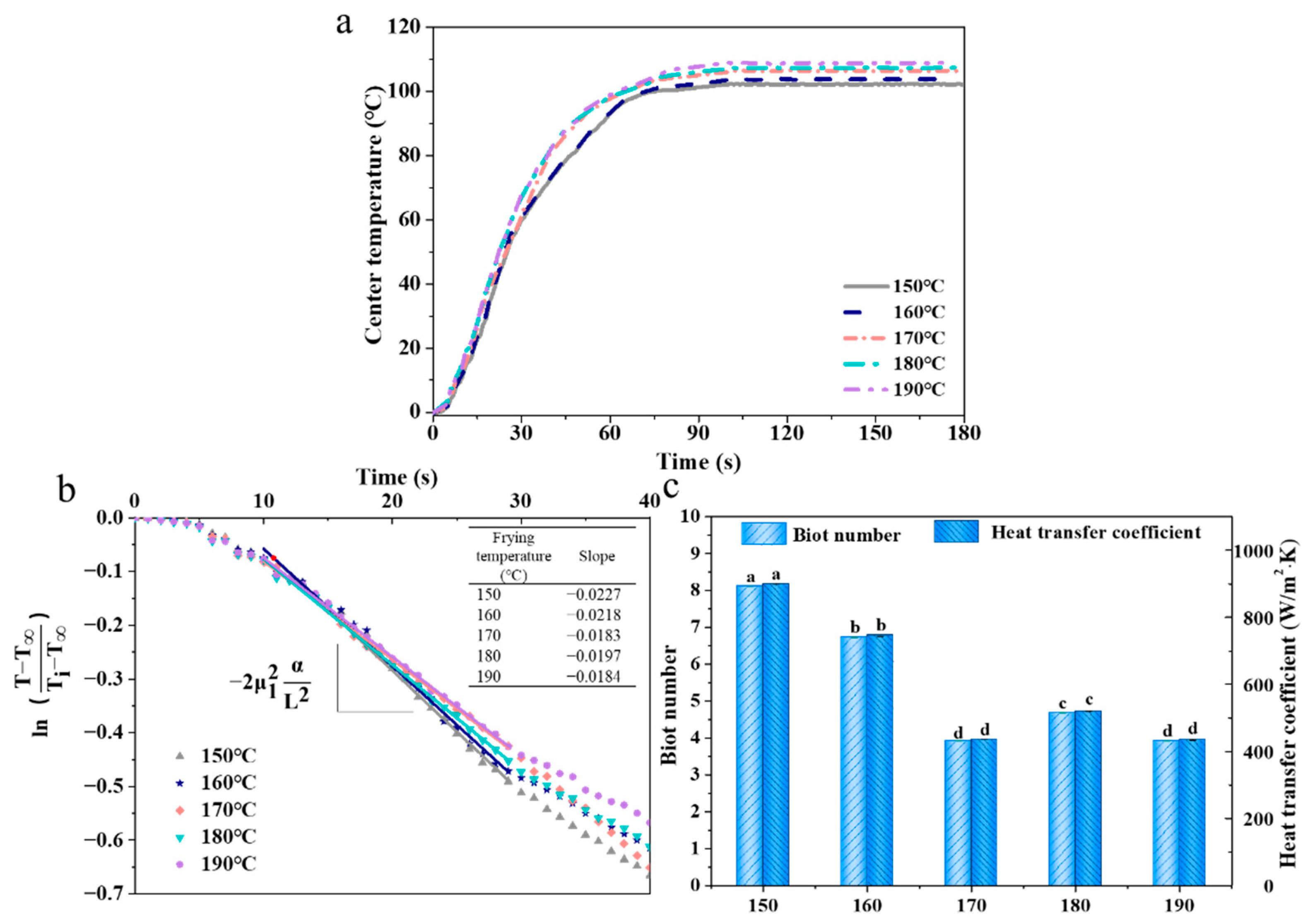
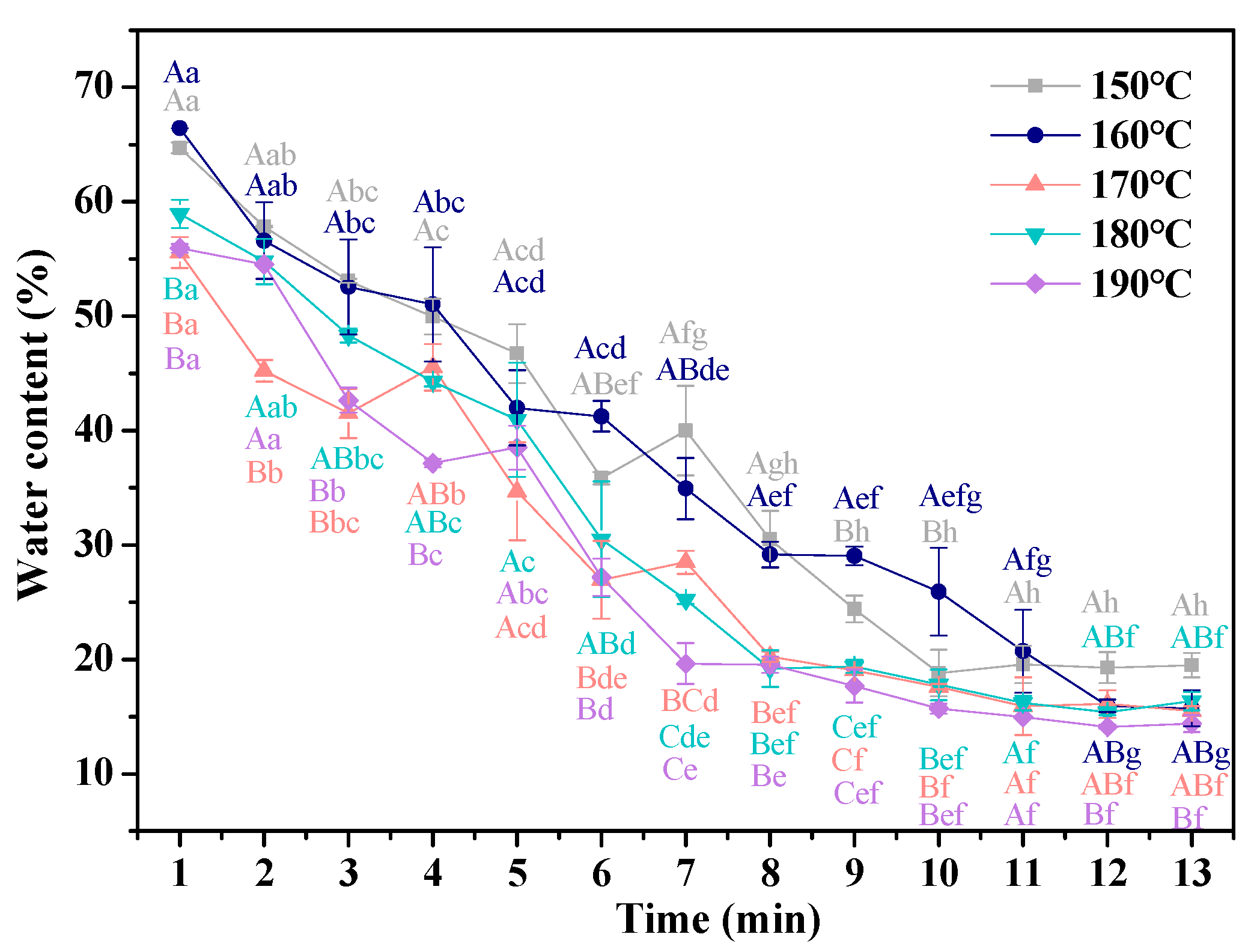
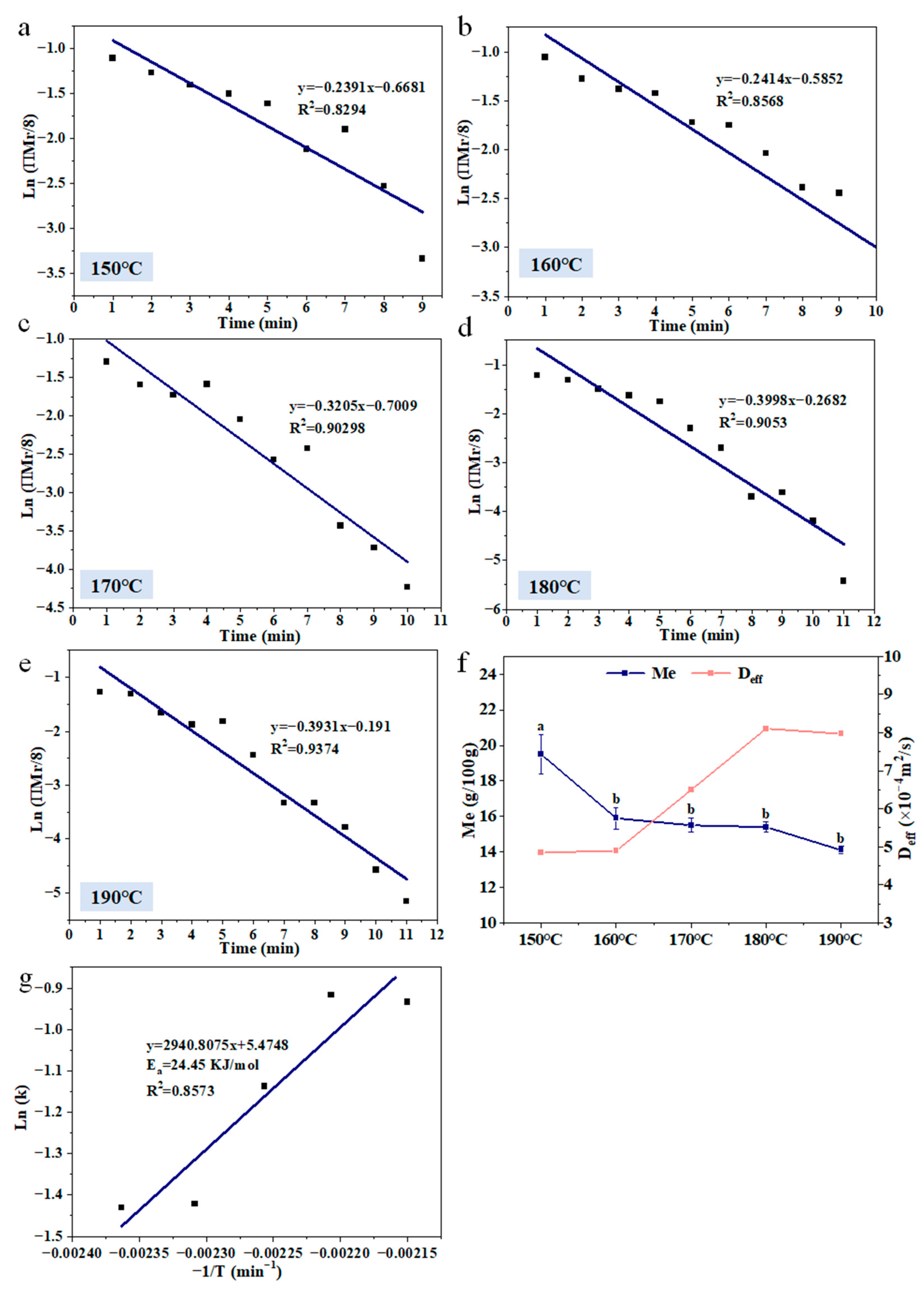
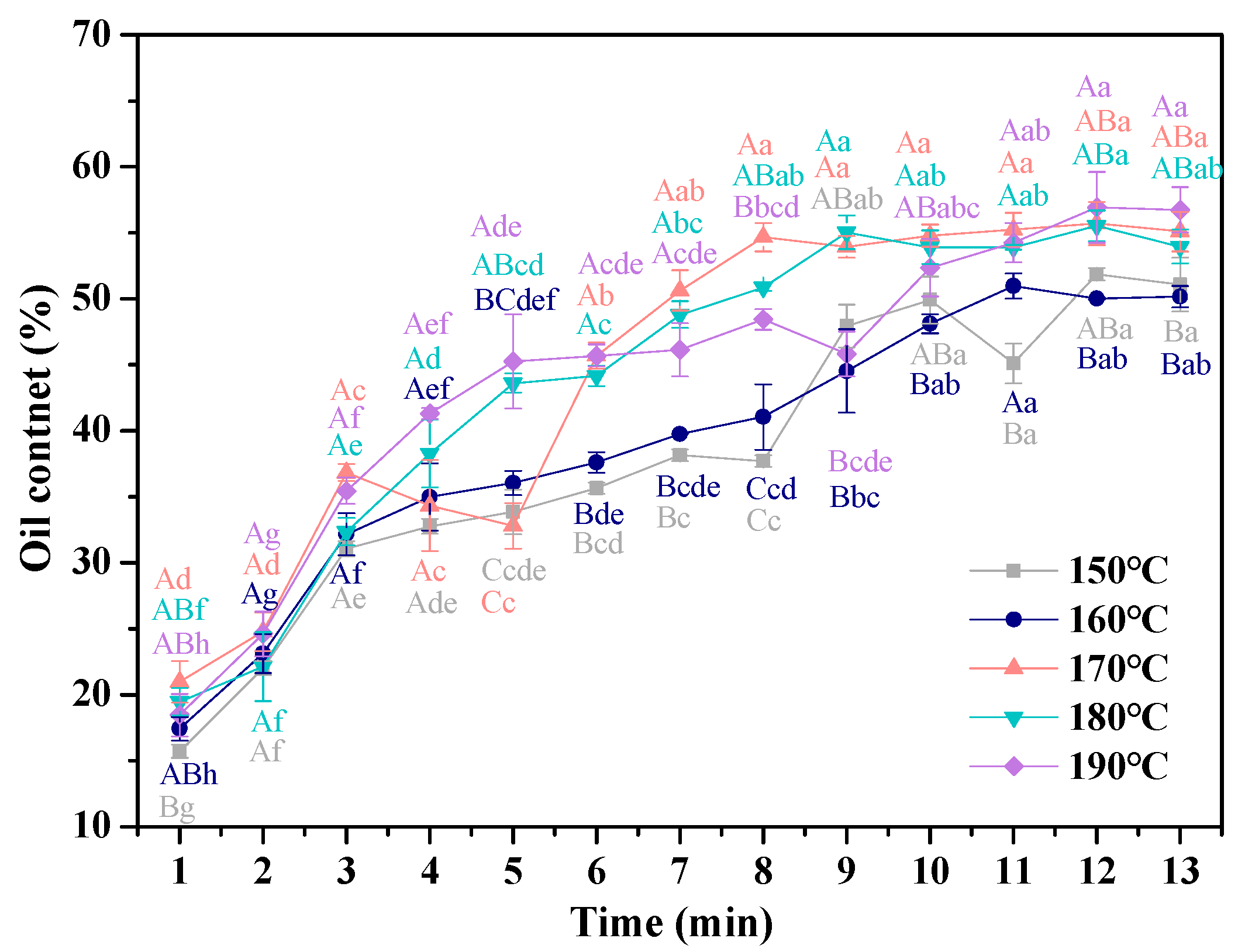
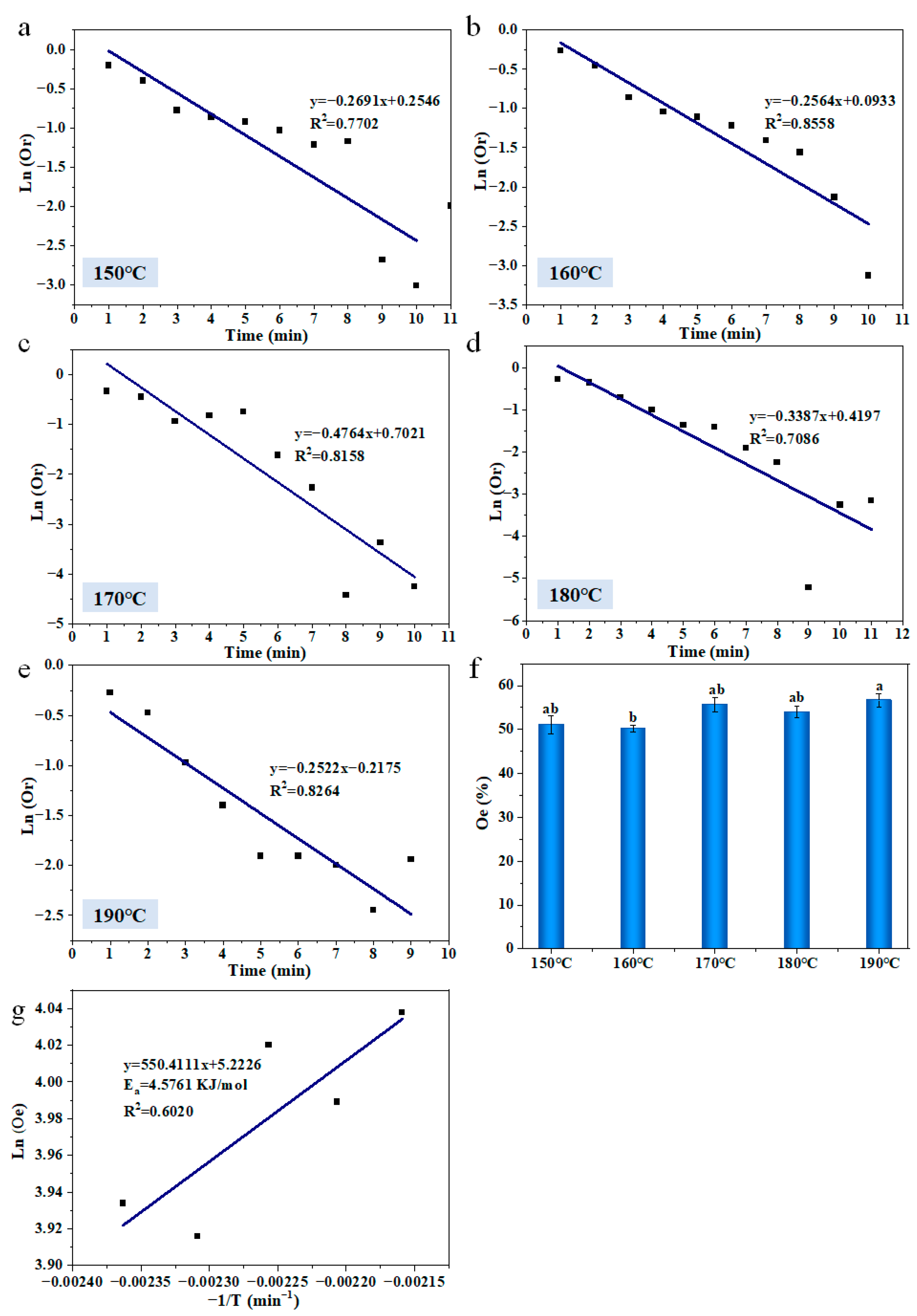
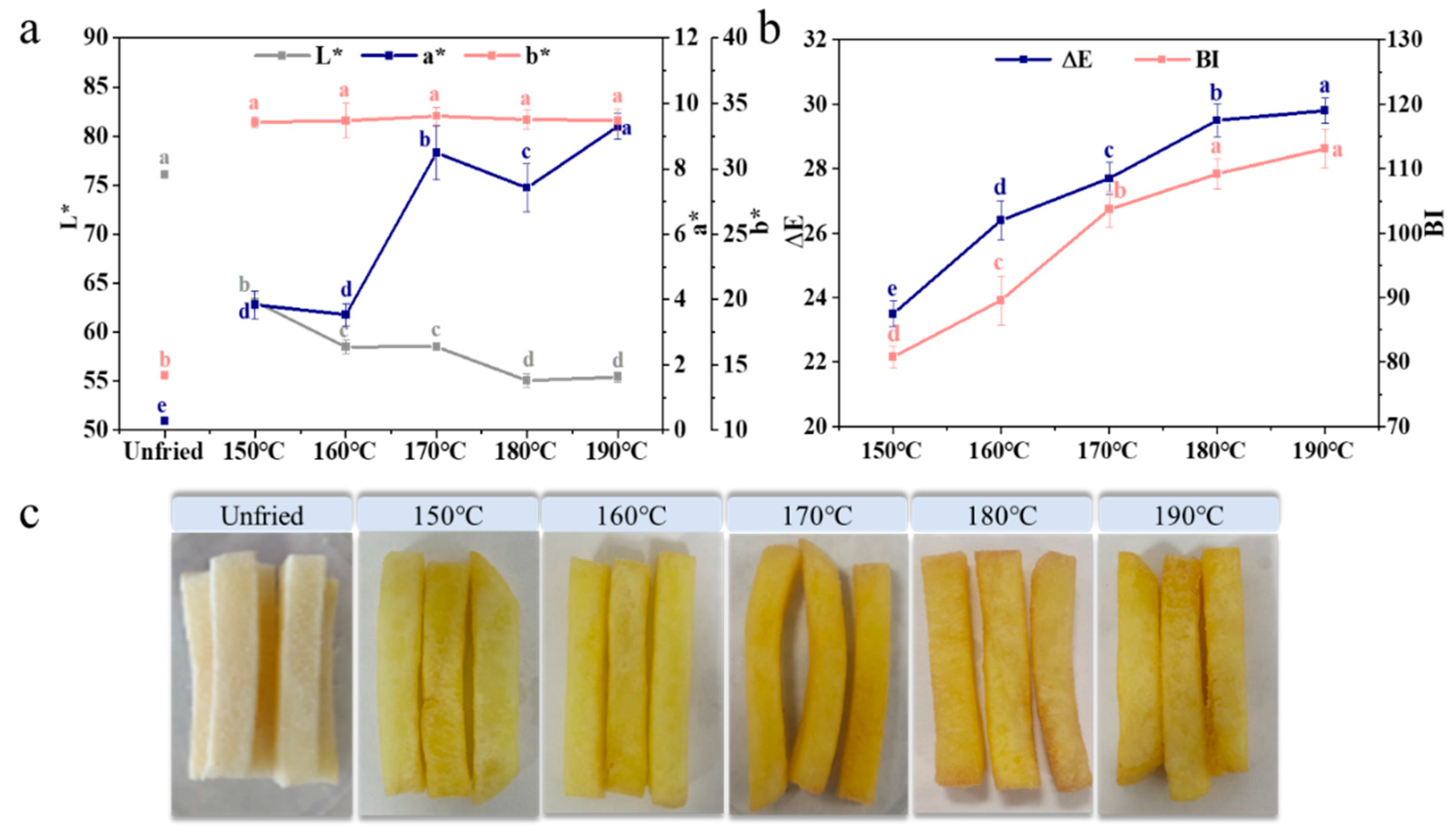
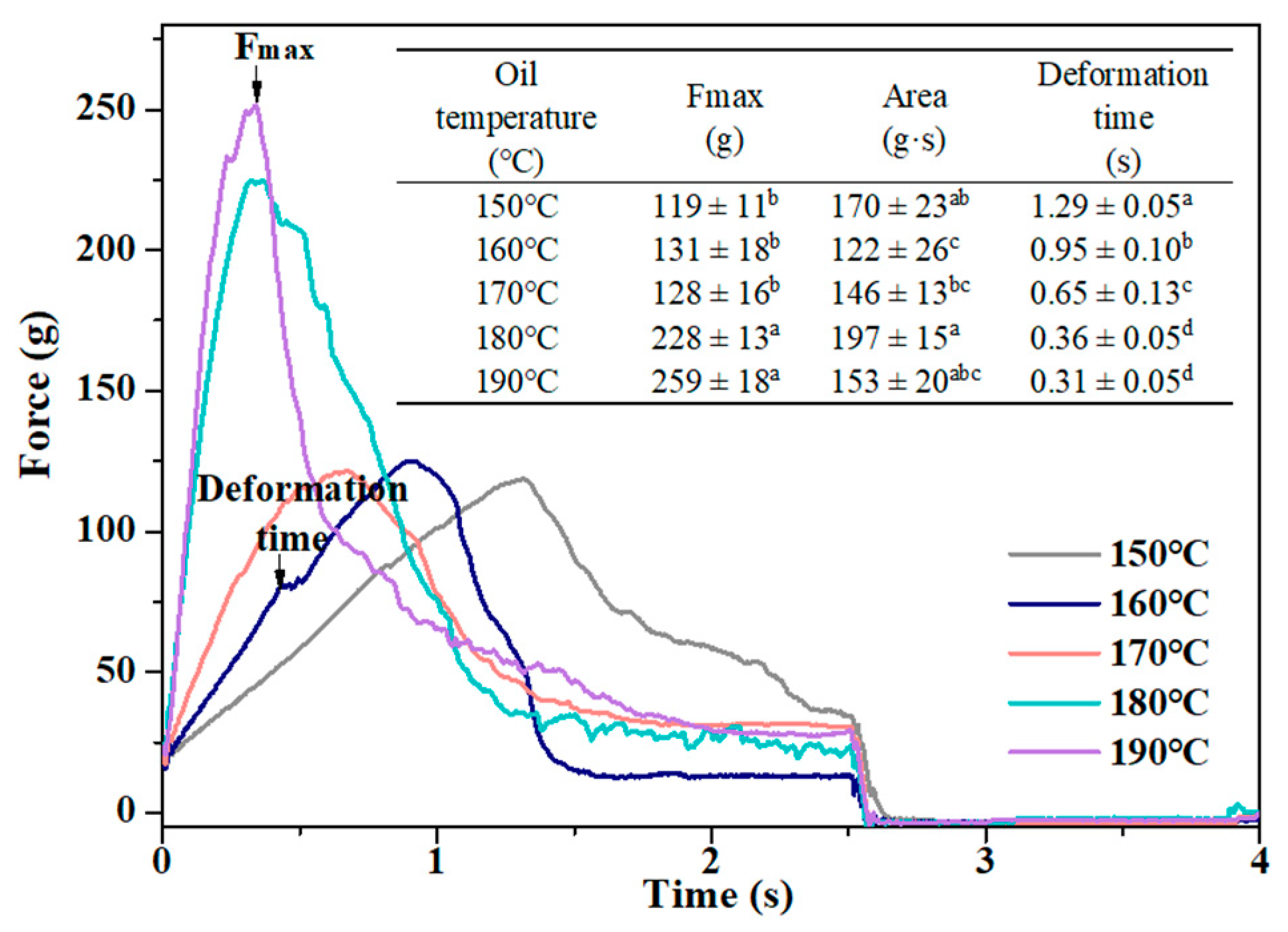
| Temperature (°C) | Color | Crispness | Aroma | Oiliness | Overall Acceptability |
|---|---|---|---|---|---|
| 150 | 6.03 ± 0.63 cd | 5.73 ± 0.79 b | 5.83 ± 1.30 a | 6.73 ± 0.92 a | 5.96 ± 1.05 b |
| 160 | 5.680 ± 0.85 d | 6.58 ± 0.84 ab | 6.28 ± 1.07 a | 6.86 ± 1.08 a | 6.45 ± 0.96 ab |
| 170 | 7.45 ± 0.60 a | 7.33 ± 0.72 a | 7.10 ± 1.05 a | 6.63 ± 1.08 a | 7.25 ± 0.79 a |
| 180 | 6.91 ± 0.29 ab | 7.03 ± 0.66 a | 7.05 ± 1.09 a | 6.70 ± 0.86 a | 7.20 ± 1.09 ab |
| 190 | 6.62 ± 0.68 bc | 7.38 ± 0.43 a | 7.18 ± 1.17 a | 6.83 ± 0.82 a | 7.10 ± 1.10 ab |
Publisher’s Note: MDPI stays neutral with regard to jurisdictional claims in published maps and institutional affiliations. |
© 2022 by the authors. Licensee MDPI, Basel, Switzerland. This article is an open access article distributed under the terms and conditions of the Creative Commons Attribution (CC BY) license (https://creativecommons.org/licenses/by/4.0/).
Share and Cite
Li, Y.; Guo, Q.; Wang, K.; Nverjiang, M.; Wu, K.; Wang, X.; Xia, X. Monitoring the Changes in Heat Transfer and Water Evaporation of French Fries during Frying to Analyze Its Oil Uptake and Quality. Foods 2022, 11, 3473. https://doi.org/10.3390/foods11213473
Li Y, Guo Q, Wang K, Nverjiang M, Wu K, Wang X, Xia X. Monitoring the Changes in Heat Transfer and Water Evaporation of French Fries during Frying to Analyze Its Oil Uptake and Quality. Foods. 2022; 11(21):3473. https://doi.org/10.3390/foods11213473
Chicago/Turabian StyleLi, Ying, Qi Guo, Kaili Wang, Maheshati Nverjiang, Kairong Wu, Xu Wang, and Xiufang Xia. 2022. "Monitoring the Changes in Heat Transfer and Water Evaporation of French Fries during Frying to Analyze Its Oil Uptake and Quality" Foods 11, no. 21: 3473. https://doi.org/10.3390/foods11213473
APA StyleLi, Y., Guo, Q., Wang, K., Nverjiang, M., Wu, K., Wang, X., & Xia, X. (2022). Monitoring the Changes in Heat Transfer and Water Evaporation of French Fries during Frying to Analyze Its Oil Uptake and Quality. Foods, 11(21), 3473. https://doi.org/10.3390/foods11213473






